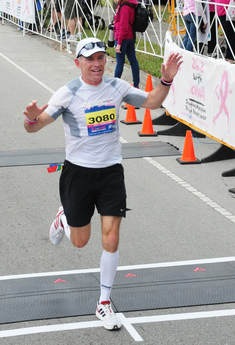 Mike Ryan, PT, ATC and RUNNER!
Mike Ryan, PT, ATC and RUNNER! Without further ado, here are Mike’s top ten tips!
1. Take Care of Your Dogs
Your feet are your base of support and the home of thousands of nerve receptors. Proper shoes, thin running socks, strong toes muscles and smart blister control are simple ways to keep you running with happy feet.
2. Respect the Hills
Running up and down hills drastically alter the stress on your knees, ankles and low back. Controlling the intensity and the volume of your hill running will allow your body to adapt to the change in terrain. A flat 4 mile run is much easier than a 3 mile hilly run so plan accordingly.
If you’re a runner, you MUST be using a leg roller 1-3x/day. It’s a simple tool and it works. It’s my MVP when it comes to relaxing my quads and IT bands both before and after a run. So you don’t have time? It takes less than 2 minutes per leg. Simply stated; 4 minutes on a roller can be the difference between you running with your SW friends tomorrow morning and sitting at home with knee pain.
4. Ice, Ice Baby
Ice is your best friend. It helps decrease pain, reduce swelling and accelerate your recovery. A bag of frozen peas is good but….a ziplock bag with crushed ice/water or an ice massage with a frozen papercup of ice is MUCH better. It’s uncomfortable, yes, but it works! It takes about 4 minutes for the area being treated to go numbs and after that, it’s easy. My general rule of thumb is to avoid icing any longer than 12 minutes to avoid complications.
Strong quads - the muscles in the front of the thigh - are so important for runners. These 4 muscles absorb a majority of the load when your feet pound on the road. Therefore, keeping these key muscles strong, flexible and happy should be a high priority for injury-free runners young and old.
6. Running Waves
Running in the shallow and/or deep end of pool is a smart way to enhance your fitness, protect your joint surfaces, change up your routine and strengthen your core.
7. Total Body Care
We use every muscle group when we run so training the entire body is wise. Core strength, flexible shoulder muscles, strong feet and erect posture are just a few of the “other things to do” besides logging high miles behind the stroller.
Hydrating with water, simple sports drinks, plenty of fruits/veggies and healthy proteins will help a runner perform well and recover faster. Minimizing potentially unhealthy shortcuts like supplements, “energy” drinks, crazy diets and processed food are traits of runners with long running careers.
9. Compress the Calves
Leg swelling is common for older adults on their feet for most of the day. Calf compression sleeves are a simple way to reduce swelling and reduce the risk of calf strains.
10. Listen to Your Body
No one knows your body better than you do. As we tell our kids: “Please listen to me”….our bodies are saying the very same thing to ourselves. (a pause to let that powerful analogy run through your mind for a moment). It’s always comforting to have running partners to join you for your runs but maybe your knee or your heel needs a day off this morning. Or maybe your legs feel extra fresh today and they’re screaming at you to run a little faster for the last 2 miles of your run. Make listening to your body a habit. Our bodies are much smarter than we give them credit for so let’s “be good listeners” so we can avoid overuse injuries and keep on running!
Mike Ryan, PT,ATC
www.MikeRyanSportsMedicine.com
Thank you so much Mike for sharing your wisdom with us!
 RSS Feed
RSS Feed